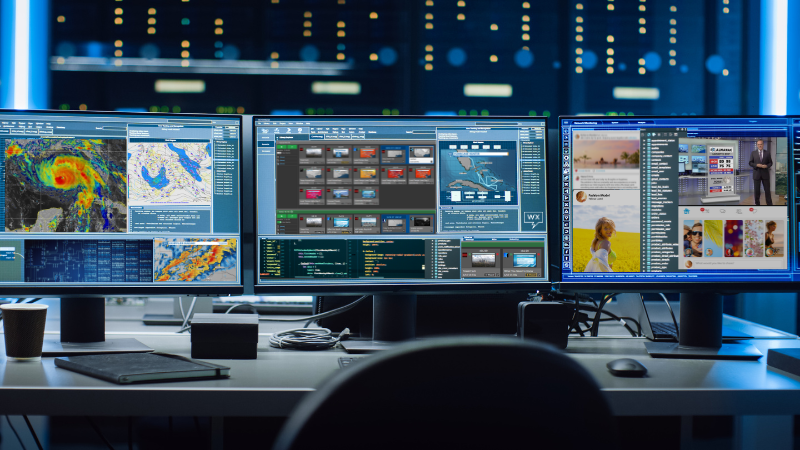The Weather Workstation of the Future

Not a day goes by that I don’t get an email or read an article about artificial intelligence. I’m feeling the same way about AI as I did when someone first told me about the “world wide web.” I don’t fully understand it, but I know this is part of our future, and the future starts now.
“Don’t think of AI as something that replaces people. Instead, see it as a revolutionary new tool that allows people to do a better job,” says Hank Price, who spent 30 years leading television stations for Hearts, CBS, and Gannett. In an article for TVNewsCheck, he wrote, “Artificial intelligence will give more creative control to real people, make their products better and open new horizons for television news.”
________________
FREE DOWNLOAD: CHATGPT PROMPTS FOR BROADCAST METEOROLOGISTS
________________
One of the biggest challenges for broadcast meteorologists today is finding time to get everything done. I hear it from my coaching clients. I read the complaints in a private broadcast meteorology Facebook group. I felt that way when working on-air at KTRK in Houston. Broadcast meteorologists are some of the busiest people in the newsroom. They simultaneously juggle six different jobs all day long.

The workload is more demanding than it was just five years ago. And it keeps piling up. Local television stations have added hours of extra newscasts, which means many more weather hits. Many broadcast meteorologists produce content for newscasts on partner television stations in the same market. CTV streaming apps require frequently updated content to keep up with the changing weather. Soon, NEXGEN TV will offer broadcast meteorologists an opportunity to personalize the weather content to specific neighborhoods.
More work doesn’t mean more people. With diminished advertising dollars and reduced cable retransmission fees, many local television stations have been forced to minimize news staff, even as the demands for more content increase.
Automation is lightening the workload a little for those that remain. Computer software can execute repeated tasks the same way every time. For example, the Weather Company’s PRISM system automatically publishes the forecast and other weather graphics on the station-branded website and mobile app. Artificial intelligence could take automation to the next level by changing the type of content published based on current and forecast weather conditions. And not just for the website but for the on-air broadcast, too!
Out of necessity, broadcast meteorologists need artificial intelligence to help produce, publish, and post weather content that meets the needs of contemporary consumers.
Imagine this
A broadcast meteorologist walks into the television studio and logs into the weather workstation. Immediately, three monitors light up. On the left is meteorological data and a detailed 14-day forecast for the meteorologist to review. The middle monitor displays a set of weather hits, teases, and webcasts. On the right, another monitor features first drafts of web articles and social media posts.
All of it is curated and generated by artificial intelligence.

If, after analyzing the weather data, the meteorologist changes some of the details in the forecast, AI automatically adjusts the content of the weather hits and rewrites the social media posts and web articles.
Should the meteorologist change some of the graphics pre-selected for the on-air weather hits, AI learns how this meteorologist likes to tell the weather story.
As the meteorologist edits the social media posts and web articles, AI learns the writing style of the meteorologist. Once approved, content is eventually published by AI in order to achieve maximum engagement.
Over time, AI refines its output to align more closely with the meteorologist, minimizing the need for adjustments and editing. With artificial intelligence assisting in every aspect of the weather production process, broadcast meteorologists can finally focus on what they do best: communicating complex weather information.
Anchors Away?
Price doesn’t think AI will replace the on-air anchor job. “You don’t need a research study to know viewers prefer to watch real people rather than a computer-generated re-creation, no matter how natural that pseudo being might appear to be,” he writes.
Yes, but AI could be used to quickly deliver critical information on digital platforms during emergencies or downtimes.
Imagine a Tornado Warning is issued in the middle of the night or between weather shifts. Ideally, you’d have someone at the station on standby, but surprise weather events happen occasionally. Or let’s say the National Weather Service issues a warning in the middle of a newscast. In both cases, a realistic computer-generated version of the on-air meteorologist could deliver the notification on digital outlets, along with a list of neighborhoods in the storm’s path, the estimated arrival time for each location, and important safety tips, all generated and personalized by artificial intelligence.
Television stations already program pre-recorded weather alerts for their website and mobile apps. It’s a short leap to imagine these videos could feature computer-generated versions of the weather team, delivering AI-generated content based on specific weather conditions.
Real Weather Content Generated with Artificial Intelligence
Already, ChatGPT can translate generic weather data into conversational text. Colossyan and Synthesia can convert that text into a video using a custom avatar.
Shel Winkley, Chief Meteorologist at KBTX in Bryan-College Station, has been experimenting with audio AI using ElevenLabs and Adobe Enhance. The AI-generated voice-matched audio track is personalized and sounds just like Winkley.
“The process is still a bit slow, but it could help in a pinch,” Winkley says. “The biggest benefit so far: when there is an error in the script or corrupt file. Instead of having to re-track and a producer bugging you to do so, pop the line into AI, and Bingo, your voice track is revised with minimal effort.”
The AI video and audio components aren’t perfect. Yet. But after a couple of more years (months?) of development, it will be challenging to determine what’s real and what’s AI.
The individual AI pieces are available now. We need someone to combine them and incorporate the software into the weather workstation of the future. Someone like one of the weather vendors every television station uses. Hello, Baron Weather and The Weather Company. Are you listening?
AI is the Answer
Much like the development of videotape, satellite and microwave transmission, and the Internet, artificial intelligence will profoundly affect television and every business. Price thinks it will create a deeper divide between good and bad stations. “The best owners, those that understand the long-term value of quality local news, will see AI as a way to expand their content and thus become stronger,” he says.
With many television stations trimming staff to the bare bones, artificial intelligence might be the only way newsrooms can fulfill the demand for more content broadcast and digital content. It may be the answer we need at a time when we need it most.
________________
Tim Heller is an AMS Certified Broadcast Meteorologist, Talent Coach, and Weather Content Consultant. He helps local TV stations and broadcast meteorologists communicate more effectively and efficiently on-air, online, and on social media.
